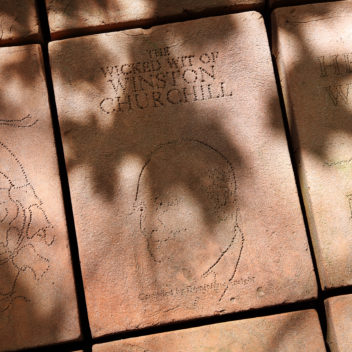
Copertine (Book Covers) Elena Tardivo
Biblioteca oscillates between installation and sculpture. At first sight it appears as a pile of bricks, perfunctorily stacked upon each other, giving the impression of being more of a stockpile rather than a library. In another way—more than an object in a space—Biblioteca also serves to define the space, not necessarily an object in a space, which is why it can also be considered an installation. In addition, the work is also a sculpture. The strong nature of terracotta gives much importance to the volumes that create the piece. Its unique realization confers a strong sense of craft. The covers of existing books are represented in each of the wider surfaces of the two hundred bricks that compose Biblioteca. Each brick measures 18.8 x 15.75 x 3.3 inches and weighs approximately 44 lbs.
The artist, in collaboration with The Fornace Curti in Milan, produced every single piece of the artwork by hand, using a technique that allows the image of the printed book covers to be transferred onto the clay through a fretwork made on crude bricks.
The way in which Biblioteca was conceived and took form from the artist’s intentions, as well as the way in which it appears to the eyes of spectators, clearly show the two key themes around which the work was developed; there is its sedentary character on one hand, and its dynamic, more progressive nature on the other.
The use of bricks, together with reference to libraries and encyclopedias, evoke a sense of solidity and durability. The dimensions of the book-bricks were specifically chosen to represent those of large encyclopedias volumes. In an interview given in 1996, Arienti said “To me, making lists is a way to think and closely relates to my encyclopedic spirit. Classifications,
to me, are a research tool and not a system of control”. Stefano Arienti’s Biblioteca wants to be the place of a standing memory as well as the place of a growing one. The book covers reproduced on the bricks of Biblioteca have been carefully chosen by both the artist and Nancy Olnick and Giorgio Spanu to symbolize their different cultural backgrounds. This diversity creates a dynamism in the exact point where things stay, affecting the bricks as well. As these bricks will be installed outside and endure through the passage of time, they will be witness to the effects that time itself has on them.
The sedentary nature of this work in contrast to its evolving nature is one of the main themes of Stefano Arienti’s art. In Biblioteca, Arienti reinvents and exalts this dynamic, linking this most recent work to his personal artistic history. In another occasion Arienti declared “I’ve learned the history of art by making it. In this very act of making, we can retrace the signs of an artistic path that ploughed the field of great Italian tradition, seeking a confrontation with it”. Biblioteca explicitly refers to Alighiero Boetti’s columns of books, but also to the formal research of Piero Manzoni and Lucio Fontana, who put at the core of their work the practice of the elimination, of the abolition of the unessential. Fontana was the first who drew with the void and Stefano Arienti’s fretworks can be seen as a renewed attempt to draw with the void. In fact the fretworks are created by the scraping out and surgical removal of material. However they can also be seen as the addition or insertion of drawing into the piece according to the Renaissance tradition, to which drawing was the basis for the realization of all other forms of art.
It could be said that Arienti, in representing his own art history, is in fact giving representation to that evolving nature that represents each of the two poles of his artistic practice. Yet, in his works, evolution doesn’t necessarily imply progression.
It is, indeed, more about the intimate connection that binds things to the passage of time, to the unpredictable way in which time modifies them, always enriching them, as will be the case of the bricks in Biblioteca, whose surfaces will undergo a process of degradation, and, simultaneously, will be covered by new matter such as musk, plants or mold. One must also recognize that the practice of fretwork itself also echoes this meaning since, in its creation, it recalls the twofold action of fire and acid—they are, at the same time, both a violation and a purification.
Maybe in Biblioteca, the most complex dialogue is the one that the artist engages with himself and the cycles, open or closed, of his past. This work puts a strong emphasis on the installation itself and it must be noted that Arienti began to make installations only in the second half of the 90’s, when he began reflecting on his own art. Biblioteca markedly evokes memories of his 1989 work I disegni dei Maestri, which was realized by coloring mold. Biblioteca is also the way in which Arienti returns to the use of terracotta after twenty years and, at last, it refers to all the times Arienti has carved, corroded, scratched and traced the material.
Things that we remember are different from those that we merely know. They appears in our minds as if we have always known them. Sometimes we happen to forget things we have learned and the only memory they leave is the knowledge of having known them. The unreadable books of Stefano Arienti retain and exist on their own inner memory—a memory that could be tarnished, abraded, corroded, but, according to the very same logic of memory, they cannot cease to be true.